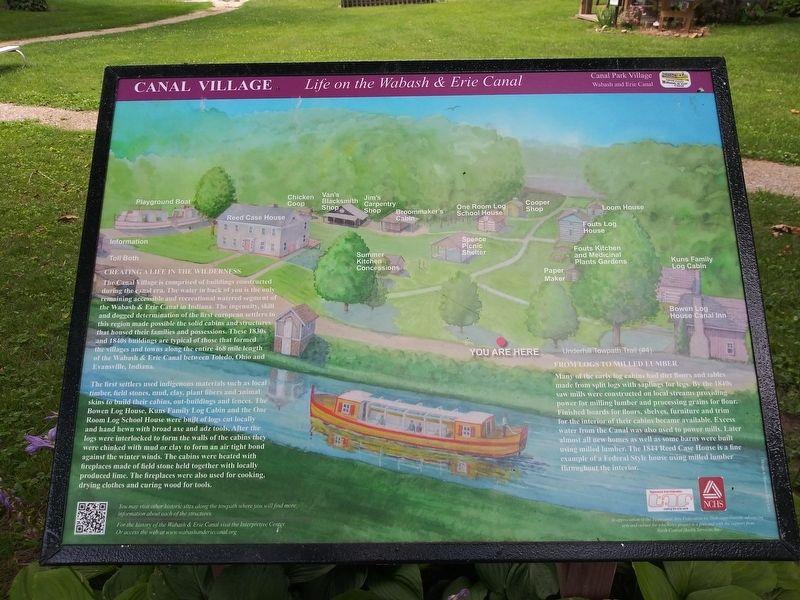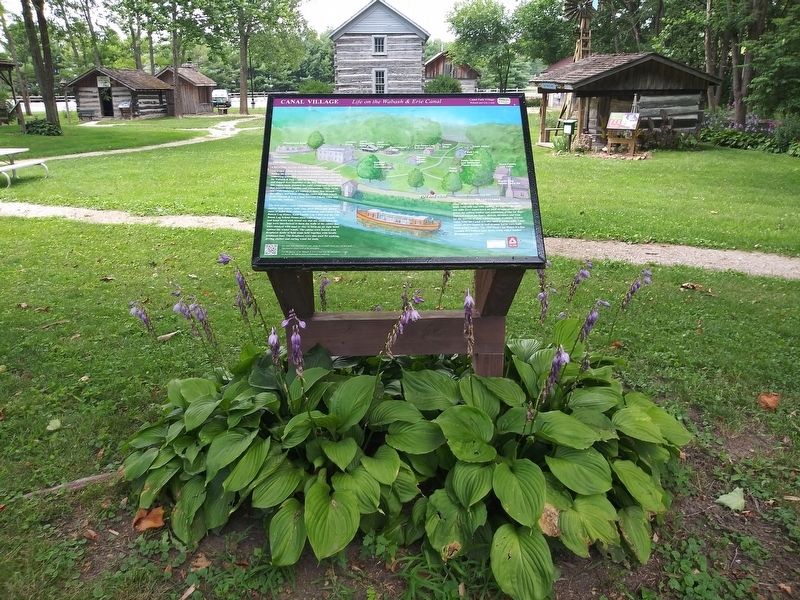Delphi in Carroll County, Indiana — The American Midwest (Great Lakes)
Canal Village
Life On the Wabash & Erie Canal
— Wabash & Erie Canal Park Village —
Creating a Life in the Wilderness
The Canal Village is comprised of buildings constructed during the canal era. The water in back of you is the only remaining accessible and recreational watered segment of the Wabash & Erie Canal in Indiana. The ingenuity, skill and dogged determination of the first European settlers to this region made possible the solid cabins and structures that housed their families and possessions. These 1830s and 1840s buildings are typical of those that formed the villages and towns along the entire 468 mile length of the Wabash & Erie Canal between Toledo, Ohio and Evansville, Indiana.
The first settlers used indigenous materials such as local timber, field stones, mud, clay, plant fibers and animal skins to build their cabins, out-buildings and fences. The Bowen Log House, Kuns Family Log Cabin and the One Room Log School House were built of logs cut locally and hand hewn with broad axe and adz tools, After the logs were interlocked to form the walls of the cabins they were chinked with mud or clay to form an air tight bond against the winter winds. The cabins were heated with fireplaces made of field stone held together with locally produced lime. The fireplaces were also used for cooking, drying clothes and curing wood for tools.
From Logs to Milled Lumber
Many
Erected by Tippecanoe Arts Federation.
Topics and series. This historical marker is listed in these topic lists: Settlements & Settlers • Waterways & Vessels. In addition, it is included in the Wabash & Erie Canal series list. A significant historical year for this entry is 1844.
Location. 40° 35.5′ N, 86° 40.783′ W. Marker is in Delphi, Indiana, in Carroll County. Marker can be reached from West North Washington Street just east of North Charles Street, on the right when traveling east. The marker is on the Grounds of the Wabash & Erie Canal Conference & Interpretive Center. Touch for map. Marker is at or near this postal address: 12252 West North Washington Street, Delphi IN 46923, United States of America. Touch for directions.
Other nearby markers. At least 8 other markers are within walking distance of this marker. Canal Bridges (a few steps from this marker); The Paper Maker's Shop (within shouting distance of this marker); Cabin Homestead 1830s (within shouting distance of this marker); Fouts Kitchen And Medical Plants Garden (within shouting distance of this marker); The Cooper (within shouting distance of this marker); Education Along The Canal (within shouting distance of this marker); Broom Maker (within shouting distance of this marker); The Broom Making Process (within shouting distance of this marker). Touch for a list and map of all markers in Delphi.
Credits. This page was last revised on December 25, 2020. It was originally submitted on December 25, 2020, by Craig Doda of Napoleon, Ohio. This page has been viewed 104 times since then and 8 times this year. Photos: 1, 2. submitted on December 25, 2020, by Craig Doda of Napoleon, Ohio. • Devry Becker Jones was the editor who published this page.

